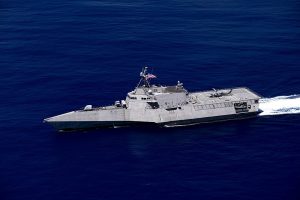U.S. Navy officials have confirmed that six of its Littoral Combat Ships (LCSs) will deploy this year, the most ever for a ship class the Navy has operated for more than a decade but that has been hampered by mechanical, maintenance, and operational problems.
USNI News reports that by the end of the year four Independence-type LCSs will be deployed to the Western Pacific, while two others will operate in Central and South America.
Two different LCS designs were initially built: the Freedom variant, a traditional mono-hull design, and the Independence variant, an advanced trimaran. The Navy’s original plan was to let the two designs compete, select one winner, and then build out the rest of the planned class of 50 ships. However, the Navy decided to build both designs, which immediately created significant problems as the two ships were so different that neither crews nor parts were interchangeable between them.
Promises that the ships’ advanced design and automation would permit radically smaller crews proved illusory, and even after the crew sizes were nearly doubled, the crews remain plagued by fatigue and overwork problems. Earlier this year, the Navy decided that mechanical problems with the Freedom variant were so serious that it halted delivery of completed ships and is requiring the shipyard to develop a fix for the 10 hulls already in service.
Major questions remain about the role LCS should play and whether they provide the right mix of capabilities for the missions the Navy has to fulfill while its ship numbers are limited by budget and construction restraints.
Vice Admiral Bill Merz, commander of the U.S. Seventh Fleet based in Japan, is a loud supporter of the LCS. When the aircraft carrier USS Theodore Roosevelt was sidelined by a COVID-19 outbreak in the spring of 2020, he claimed that the LCS USS Gabrielle Giffords “pretty much owned the southern South China Sea,” saying the ship “just kept out there pounding away, blowing up every Chinese operation. It was pretty impressive work.”
It is not clear what Chinese operations Merz asserts that the Giffords supposedly interrupted, or how, or why. Many LCS hulls have now been upgraded with the Naval Strike Missile to provide the otherwise lightly armed ships a potent anti-ship capability, but other promised capabilities, especially a mine-sweeping package, have been slow to be delivered.
But Merz says the ships operate well in shallower, archipelagic environments like the South China Sea and Japan’s Ryukyu Island chain, where their primary mission will be to support the U.S. Marines’ new expeditionary basing concepts. In that role, he says, the LCS can take on lower-intensity missions to free up a destroyer or cruiser to conduct more advanced operations in deeper waters.
The U.S. Navy now has 23 LCSs in commission and plans to build 15 more. The Navy requested the decommissioning of the four oldest ships of the class this year (commissioned between 2008 and 2014), which are plagued by persistent mechanical and maintenance issues, but there are early signs are that the U.S. Congress will only authorize the oldest of the four, the USS Freedom, to be retired.

































